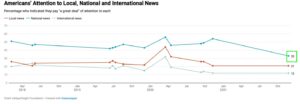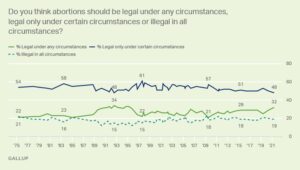In the marquee race of Tuesday’s primaries, Pennsylvania Lt. Governor John Fetterman won an impressive victory in the Democratic primary for the open U.S. Senate seat. New York Times writer Michael Sokolove has the most revealing take on Fetterman’s victory. Some excerpts:
Conor Lamb, 37, a Pittsburgh-area congressman, would have been a more conventional choice. His House voting record tracks to the center, and he has been compared to the state’s three-term Democratic senator, Bob Casey, a moderate and the son of a former Pennsylvania governor….Mr. Fetterman, 52, offers something different, a new model for Pennsylvania. It is built on quirky personal and political appeal rather than the caution of a traditional Democrat in the Keystone State. With over 80 percent of the votes counted, Mr. Fetterman was more than doubling the total of Mr. Lamb, whose campaign, despite winning many more endorsements from party leaders, never gained momentum.
….Mr. Fetterman’s one glaring departure from progressive causes, and a nod to Pennsylvania realpolitik, is that he does not support a ban on fracking, the environmentally questionable hydraulic extraction of natural gas. Tens of thousands of Pennsylvanians have benefited financially from it by selling drilling rights on their land, working in the industry or both.
….In the fall, Mr. Fetterman will need to pile up huge winning margins in Philadelphia and Pittsburgh and win by healthy margins in their suburbs and the state’s few other pockets of blue in order to withstand the lopsided totals that Republicans win nearly everywhere else….In less populous counties, as recently as 2008, Barack Obama took 40 percent of the vote or more, but as polarization has increased, Democrats have struggled to get even 25 percent…..Mr. Fetterman’s background, his attention to the state’s rural communities and his manner — the work clothes, a straightforward speaking style — could make some difference….
Some choice observations about Democratic votes in other states from “May 17 Primary Elections: Updates And Results” at FiveThirtyEight:
- The Democratic primary in Pennsylvania’s 12th Congressional District remains too close to call. There, progressive state Rep. Summer Lee holds a tiny 523-vote lead over establishment-backed Steve Irwin. Since this is an open, solidly blue seat, Lee was seen as one of progressives’ best chances to add to their numbers tonight. She looks like she’s in good shape, but we don’t know how many ballots are outstanding and it’s possible Irwin could close the gap.
- In Oregon’s 5th District, progressive challenger Jamie McLeod-Skinner leads incumbent Democratic Rep. Kurt Schrader by 18 points, 59 percent to 41 percent, but only a third of the vote is counted and an issue with ballots in Schrader’s home county could keep the race in suspense for a while. At the very least, though, the fractious Democratic primary has Republicans thinking they can make a play for this seat in the fall; former Happy Valley mayor Lori Chavez-DeRemer leads businessman Jimmy Crumpacker 41 percent to 32 percent in the GOP primary.
- One bright spot for House Democrats this cycle, however, has been North Carolina, and the good news continued tonight. In both of the state’s two most competitive districts — the 1st and the 13th — Republicans nominated candidates that could cause them difficulties in the fall. In the 1st, 2020 Republican nominee Sandy Smith narrowly cleared the runoff threshold with 31.4 percent, but she is a candidate with a troubled track record as she has been accused of domestic violence and financial impropriety. Meanwhile, in the 13th, the winner was Bo Hines, a 26-year-old first-time candidate who spent much of the last year jumping from district to district before settling on this one. Biden would have narrowly carried the suburban district, which is trending in Democrats’ direction, so Hines’s relatively untested profile and lack of ties to the area could pose a problem for him in the general. Democrats nominated state Sens. Don Davis and Wiley Nickel in the 1st and 13th, respectively.
- It’s not all good news for Democrats in North Carolina, though. Notably, Rep. Ted Budd easily topped former Gov. Pat McCrory by more than 30 points in the GOP primary — McCrory managed to lose reelection in 2016 despite Trump winning the state at the top of the ticket. Former state Supreme Court Chief Justice Cheri Beasley easily won the Democratic nomination on the other side, but given that North Carolina is a red-leaning state and the electoral environment is shaping up to be favorable for Republicans, this will be a challenging race for Democrats. Inside Elections, the Cook Political Report, and Larry Sabato’s Crystal Ball all rate the race as Lean Republican.
The FiveThirtyEight panel has a lot more to say about the Republican primaries, as well as the Democratic contests. Read it all at this link.






